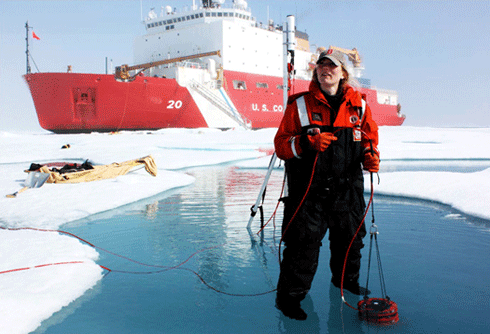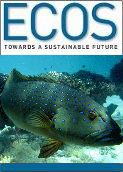
|
Published: 18 June 2012
Algal bloom under arctic sea ice linked to climate change
A massive phytoplankton bloom discovered beneath pack ice in the Arctic is linked to climate change and may require a rethink of Arctic ecosystem processes.

|
|
ICESCAPE scientist Karen Frey taking optical measurements in a melt pond, with the US Coast Guard Cutter Healy in the background.
Credit:
NASA’s Goddard Space Flight Center/Kathryn Hansen
|
Most models of biological production in the Arctic Ocean assume a value of zero below pack ice. Sea ice and snow cover have historically reflected incoming solar radiation, leaving no sunlight for plankton in the water below.
However, Arctic sea ice cover is in decline. Changing ice conditions now allow light to penetrate large swaths of Arctic sea ice. Thick ‘multi-year’ ice, which requires several seasons to accumulate, is on the decline, while warming temperatures favor thinner ‘first-year ice’. Additionally, the melt pools that now commonly form on top of Arctic sea ice decrease the ice pack’s ability to reflect light.
The resulting under-ice environment is ideal for Arctic phytoplankton. The thin ice lets in light while protecting the algae from ultraviolet radiation.
The discovery of the bloom, reported in a recent issue of Science was made by ICESCAPE. ICESCAPE was a NASA ship-based research project, conducted in the summers of 2010 and 2011, to investigate the impact of climate change (natural and anthropogenic) on the biogeochemistry and ecology of the Chukchi and Beaufort seas, an Arctic region where climate change effects are pronounced.
The bloom, discovered in the Chuckchi sea, north of Alaska, extended more than 90 kilometres from the ice edge into the sea ice pack, and was concentrated in the top layers of water near the ocean surface. The bloom consisted mainly of diatoms, microscopic plants that make up the base of the marine food chain and require large amounts of sunlight to grow.
Expedition leader Professor Kevin Arrigo, of Stanford University, says of the algal content of the water in the bloom, ‘Not only was the value not zero, [biological] production was higher there than it was in open water.’
‘Grow rates under the ice are higher than I thought was possible for Arctic phytoplankton,’ says Prof. Arrigo.
‘Algal cells that would normally take three days to divide were doubling more than once a day.’
Based on samples from surrounding water and on the species of algae in the bloom, the scientists confirmed that the algae had not drifted under the ice from elsewhere.
While the discovery marks the first direct observation of an under-ice bloom, the conditions that allow for it in the Chukchi Sea, where it was discovered, exist over a large area of the Arctic.
‘We suspect that this is a lot more widespread than we realize,’ says Prof. Arrigo.
The appearance of under-ice blooms may presage wholesale shifts in the ecosystem of the Arctic. Colder-water phytoplankton production, as with under-ice algae, may cause organic matter to drop to the ocean floor sooner. The effect would benefit bottom-feeding species, to the detriment of species that feed in the water column.
And, as algal blooms are able to occur earlier in the year, animals that depend on timing their behavior to ‘pulses’ in algal productivity may be left out in the cold.
Increased biological productivity in the Arctic should increase its carbon capture rate, as these phytoplankton are carbon consumers. However, Prof. Arrigo is of the opinion that the effect is unlikely to make much difference.
‘Even if the amount of CO2 going into the Arctic Ocean doubled, it’s a blip on a global scale.’
Source: Stanford University



